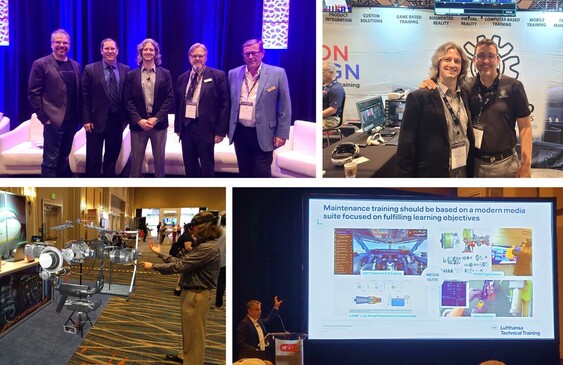 Julian Abich, Ph.D., Sr. Human Factors Engineer Julian Abich, Ph.D., Sr. Human Factors Engineer We started the year flying high by attending the SciTech 2020 Forum & Expo hosted by the American Institute of Aeronautics and Astronautics (AIAA) in the City Beautiful (a.k.a. Orlando, FL). I had two goals: find presentations on human factors topics and meet new folks within the field that are conducting training with immersive technology. After keyword searching through the digital program, I found two sessions called Augmented and Virtual Reality Technology - Human Factors and Training. Killed two birds with one stone or rather knocked out two goals with one session (weak pun). I was excited because in previous years there were only a few human factors sessions because SciTech is heavily focused on aerospace engineering. It was interesting to see how the use of immersive tech has been spreading throughout many fields and has gained importance within this domain. In one of the sessions, a presentation was given on NASA's Virtual Lab (VR) that discussed the history of the lab, the programs they've supported, and future plans. My one question was (and will likely always be) how do you show the effectiveness of using immersive tech and the benefits they support. And I was shocked by the answer that they don't do it. Not because they don't want to, but because they often don't have the resources (e.g. time, money, personnel, etc.). What continues to drive their work is the validation they receive from the astronauts. I feel this point is often overlooked, getting end-user feedback as a level of validation. And in this case, the end-users are also subject matter experts (SMEs) who can provide insight into how well the VR training will likely transfer into the real-world.
Another interesting talk was about Augmented Eye, which is a pilot instructor support tool. Instead of developing augmented reality (AR) technology specifically for trainees, they created a support tool that allows instructors and trainers to view ocular behavior of pilot trainees during training scenarios in real-time. By using the AR system combined with eye tracking, instructors can now see where pilots are looking, allowing them to immediately provide feedback or correct behaviors before ineffective strategies are developed. During the second session, there was a presentation on using VR to create what was being termed fused reality. It relates to the concept of mixed-reality by using external cameras on a VR head mounted display (HMD) to project real-world feeds within the display and then adding virtual objects within the projected environment. What really struck me as amazing is that they tested their proof-of-concept with a pilot flying a real-plane (don't worry they had a safety co-pilot). They were able to show how various tasks can be trained, such as formation flying, aerial refueling drogue tracking, and runway approach practice in mid-air, without the need of flying expensive aircrafts or requiring other physical aircrafts to be present. And further, no simulator sickness was felt. This was likely due to the low latency and true sensations felt by flying the real plane. I can see this utilized as a transition training phase between full simulator and real-world training. And although I may be biased because I am a recreational skydiver, I was very excited to learn about PARASIM. It is a parachute simulator used for pre-jump exposure and emergency egress training procedures. Users wear a VR HMD and are strapped into a parachute harness that is tethered to a frame which allows the user to experience free fall in a horizontal position. When the skydiver pulls the ripcord (since this is used for military training) to release the main canopy (a parachute for those non-divers), the user's legs are released to adjust the body back into a vertical position as it would be under canopy. Again, my question was, have you conducted any transfer of training or effectiveness studies? And again, no, they have not had the resources to support it, but they do have professional skydivers on staff that provide expert knowledge and feedback which helps validate the training content and platform physics. All in all, SciTech continues to expand and showcase some of the latest work in the aeronautics and astronautics fields with an ever increasing use of immersive technology. Looking forward to see what will be presented next year. How are you taking innovative approaches to implement immersive technology for training?
0 Comments
|
AuthorsThese posts are written or shared by QIC team members. We find this stuff interesting, exciting, and totally awesome! We hope you do too! Categories
All
Archives
June 2024
|


 RSS Feed
RSS Feed